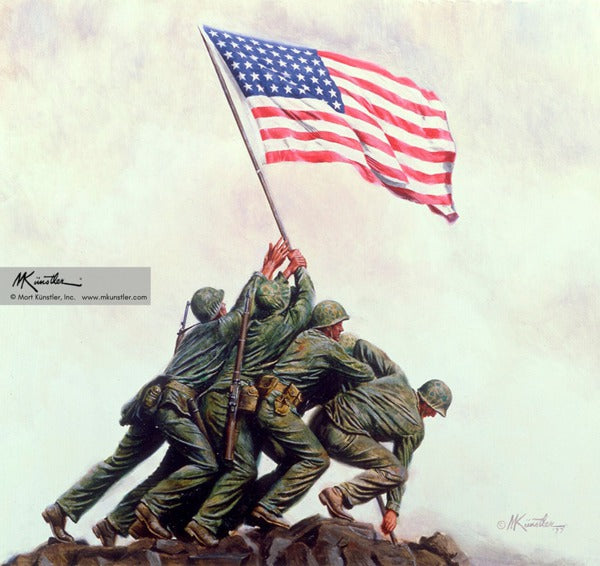The Official Mort Künstler Website
Vision of Freedom’s Victory – Cotton Fabric Panel
Vision of Freedom’s Victory – Cotton Fabric Panel
Regular price
$16.00 USD
Regular price
Sale price
$16.00 USD
Unit price
per
Tax included.
Shipping calculated at checkout.
Couldn't load pickup availability
Fabric panel of the planting of the flag at Iwo Jima.
Showcase your DIY skills with this beautiful fabric panel. There is no end to the possibilities for incorporating this into one of your favorite needlework projects. Think of all the ways this design could be used. It might become a central element in a new quilt you are envisioning. Or, you might use enhanced embroidery to accent some of the design elements and then frame it as a standalone wall hanging. Perhaps you may want to make it into a pillow. Use your imagination to create something handmade with love.
• Digitally printed
• Size: 14” x 12” approx.
• 100% cotton – white kona
• Made in the USA
Adaptation by The Posy Collection.
Posy Lough has been translating America and American history into crafts and needlework kits for more than three decades. Her kits depict the homes of our presidents, our historic sites, our gardens and farms, and our natural wonders. Each project has an underlying theme relating to our American heritage.
Historical Information
In modern wars, flags are rarely seen in combat and the days when soldiers could rally round the flag are long past. World War II was fought first in Europe where Allied strength was concentrated against Hitler. At first the war in the Pacific had second priority. Because of this, and because of the huge distances involved, the Pacific war was at first a series of defeats for the allies, but as their strength increased – especially America’s – it became a wide-ranging air and naval war which took a heavy toll on the Japanese enemy. Assault after assault on Japanese-held islands began with amphibious landings, one of which occurred at Iwo Jima, selected because it was part of the Japanese homeland and its capture would damage Japan’s morale. It was a prize target, too, because the fighter planes based there could escort the bombers all the way to Tokyo, to bring the war to the enemy. After 72 days of aerial bombing and three days of naval bombardment, 30,000 Marines swarmed ashore on its inhospitable beaches. Crossing the narrow neck of the island they pressed North from the beachhead and South up the slopes of Mt. Suribachi. On February 23, 1945, after three days of battle, Marines reached the top of Mt. Suribachi, where five Marines and a Navy Corpsman raised the American Flag. Immortalized in Joe Rosenthal's Pulitzer Prize winning photograph, it captured the vision of the ultimate victory. Iwo Jima was one of the most costly invasions of the war. It was fitting that the flag, so rarely seen in modern-day battle, was raised to their triumph. And it is fitting too, that this scene, cast in bronze by Felix de Weldon, guards the U.S National Cemetery at Arlington, Virginia, the last resting place of the nation's heroes of this commemorative.
View full details
Showcase your DIY skills with this beautiful fabric panel. There is no end to the possibilities for incorporating this into one of your favorite needlework projects. Think of all the ways this design could be used. It might become a central element in a new quilt you are envisioning. Or, you might use enhanced embroidery to accent some of the design elements and then frame it as a standalone wall hanging. Perhaps you may want to make it into a pillow. Use your imagination to create something handmade with love.
• Digitally printed
• Size: 14” x 12” approx.
• 100% cotton – white kona
• Made in the USA
Adaptation by The Posy Collection.
Posy Lough has been translating America and American history into crafts and needlework kits for more than three decades. Her kits depict the homes of our presidents, our historic sites, our gardens and farms, and our natural wonders. Each project has an underlying theme relating to our American heritage.
Historical Information
In modern wars, flags are rarely seen in combat and the days when soldiers could rally round the flag are long past. World War II was fought first in Europe where Allied strength was concentrated against Hitler. At first the war in the Pacific had second priority. Because of this, and because of the huge distances involved, the Pacific war was at first a series of defeats for the allies, but as their strength increased – especially America’s – it became a wide-ranging air and naval war which took a heavy toll on the Japanese enemy. Assault after assault on Japanese-held islands began with amphibious landings, one of which occurred at Iwo Jima, selected because it was part of the Japanese homeland and its capture would damage Japan’s morale. It was a prize target, too, because the fighter planes based there could escort the bombers all the way to Tokyo, to bring the war to the enemy. After 72 days of aerial bombing and three days of naval bombardment, 30,000 Marines swarmed ashore on its inhospitable beaches. Crossing the narrow neck of the island they pressed North from the beachhead and South up the slopes of Mt. Suribachi. On February 23, 1945, after three days of battle, Marines reached the top of Mt. Suribachi, where five Marines and a Navy Corpsman raised the American Flag. Immortalized in Joe Rosenthal's Pulitzer Prize winning photograph, it captured the vision of the ultimate victory. Iwo Jima was one of the most costly invasions of the war. It was fitting that the flag, so rarely seen in modern-day battle, was raised to their triumph. And it is fitting too, that this scene, cast in bronze by Felix de Weldon, guards the U.S National Cemetery at Arlington, Virginia, the last resting place of the nation's heroes of this commemorative.





